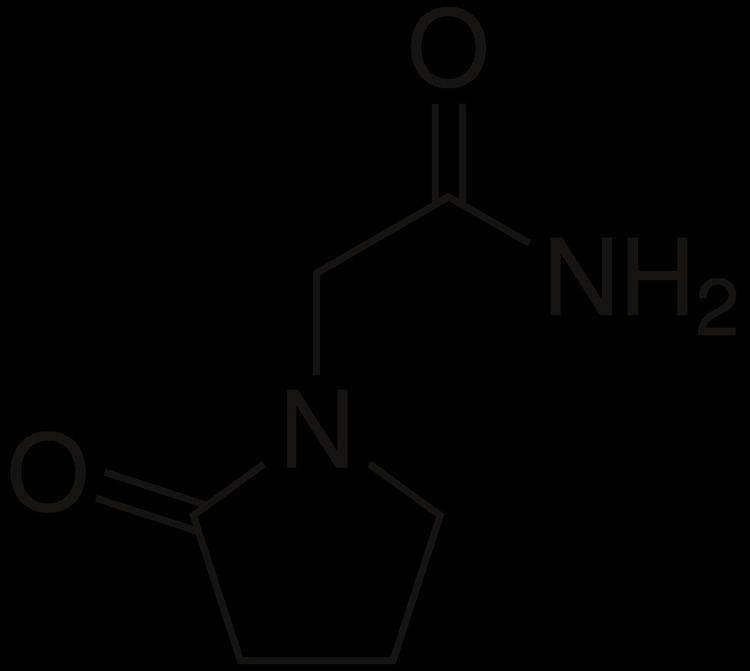ATC code N06BX03 (WHO) Formula C6H10N2O2 Molar mass 142.156 g/mol | Bioavailability ~100% CAS ID 7491-74-9 | |
 | ||
Trade names Breinox, Dinagen, Lucetam, Nootropil, Nootropyl, Oikamid, Piracetam and many others AHFS/Drugs.com International Drug Names Routes ofadministration Oral, parenteral, or vaporized Legal status AU: S4 (Prescription only)CA: UnscheduledUK: POM (Prescription only)US: Not permitted as drug or supplement IUPAC ID 2-(2-oxopyrrolidin-1-yl)acetamide | ||
Nootropics series part 2 piracetam the original smart drug
Piracetam (sold under many brand names) is a nootropic drug in the racetams group, with chemical name 2-oxo-1-pyrrolidine acetamide. It shares the same 2-oxo-pyrrolidone base structure with pyroglutamic acid. Piracetam is a cyclic derivative of GABA (gamma-Aminobutyric acid). Presently piracetam is used in many European countries, Asia and South America. In the United States, it is not approved by the US Food and Drug Administration for any medical use and it is not permitted to be sold as a dietary supplement. In the UK, piracetam is prescribed mainly for myoclonus, but is used off-label for other conditions. Evidence to support its use for many conditions is unclear.
Contents
- Nootropics series part 2 piracetam the original smart drug
- Dementia
- Depression and anxiety
- Other
- Side effects
- Toxicity
- Mechanisms of action
- History
- Approval
- Availability
- References
Dementia
A 2001 Cochrane review concluded that there was not enough evidence to support piracetam for dementia or cognitive problems. A 2002 review and 2005 review concluded that piracetam had some positive effects in older patients with these problems. In 2008, a working group of the British Academy of Medical Sciences noted that many of the trials of piracetam for dementia were flawed.
Depression and anxiety
Some sources suggest that piracetam's overall effect on lowering depression and anxiety is higher than on improving memory. However, depression is reported to be an occasional adverse effect of piracetam.
Other
Peripheral vascular effects of piracetam have suggested its use potential for vertigo, dyslexia and sickle cell anemia. A subsequent Cochrane review of the evidence did not support piracetam's use in sickle cell crisis prevention. Piracetam may have potential for the treatment of the symptoms of childhood autism.
Side effects
Piracetam has been found to have very few side effects, and those it has are typically "few, mild, and transient." A large-scale, 12-week trial of high-dose piracetam found no adverse effects occurred in the group taking piracetam as compared to the placebo group. Many other studies have likewise found piracetam to be well tolerated.
Symptoms of general excitability, including anxiety, insomnia, irritability, headache, agitation, nervousness, tremor, and hyperkinesia, are occasionally reported. Other reported side effects include somnolence, weight gain, clinical depression, weakness, increased libido, and hypersexuality.
Toxicity
The LD50 for oral consumption in humans has not been determined; however, the LD50 is 5.6 g/kg for rats and 20 g/kg for mice, indicating extremely low acute toxicity.
Mechanisms of action
Piracetam's mechanism of action, as with racetams in general, is not fully understood. The drug influences neuronal and vascular functions and influences cognitive function without acting as a sedative or stimulant. Piracetam is a positive allosteric modulator of the AMPA receptor. It is hypothesized to act on ion channels or ion carriers, thus leading to increased neuron excitability. GABA brain metabolism and GABA receptors are not affected by piracetam
It has been found to increase blood flow and oxygen consumption in parts of the brain, but this may be a side effect of increased brain activity rather than a primary effect or mechanism of action for the drug.
Piracetam improves the function of the neurotransmitter acetylcholine via muscarinic cholinergic (ACh) receptors, which are implicated in memory processes. Furthermore, piracetam may have an effect on NMDA glutamate receptors, which are involved with learning and memory processes. Piracetam is thought to increase cell membrane permeability. Piracetam may exert its global effect on brain neurotransmission via modulation of ion channels (i.e., Na+, K+). It has been found to increase oxygen consumption in the brain, apparently in connection to ATP metabolism, and increases the activity of adenylate kinase in rat brains. Piracetam, while in the brain, appears to increase the synthesis of cytochrome b5, which is a part of the electron transport mechanism in mitochondria. But in the brain, it also increases the permeability of the mitochondria of some intermediaries of the Krebs cycle.
History
Piracetam was first made some time between the 1950s and 1964. There are reports of it being used for epilepsy in the 1950s.
Approval
Piracetam is primarily used in Europe, Asia, and South America. In the United States, it is not approved by the US Food and Drug Administration for any medical use and it is not permitted to be sold as a dietary supplement. Piracetam is legal to import into the United Kingdom for personal use with or without prescription. Piracetam has no DIN in Canada, and thus cannot be sold but can be imported for personal use in Canada. It has become popular as a cognitive enhancement drug among students.
Availability
Piracetam is sold under a wide variety of brand names worldwide. Popular trade names for piracetam in Europe are Nootropil and Lucetam, among many others. In Argentina, it is made by GlaxoSmithKline S.A. laboratories and sold under the trade name of Noostan (800 mg or 1200 mg). In Venezuela and Ecuador, piracetam is produced by Laboratorios Farma S.A. and sold under the brand name Breinox. In Mexico it is produced by UCB de Mexico, and sold under the brand name of Nootropil. Other names include Nootropil in the United States, Europe, Brazil, Hong Kong, India, and Mexico; Lucetam, Oikamid, Smart, Geratam, and Biotropil in Europe and Brazil; Neurobasal in Colombia; Breinox in Ecuador and Venezuela;Stimulan in Egypt; and Nocetan in Latin America.
